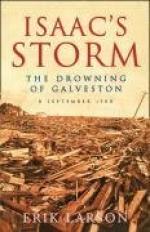|
This section contains 634 words (approx. 2 pages at 400 words per page) |

|
Isaac S Storm: The Drowning of Galveston Summary & Study Guide Description
Isaac S Storm: The Drowning of Galveston Summary & Study Guide includes comprehensive information and analysis to help you understand the book. This study guide contains the following sections:
This detailed literature summary also contains Topics for Discussion and a Free Quiz on Isaac S Storm: The Drowning of Galveston by Erik Larson.
Isaac's Storm, by Erik Larson, is the story of the hurricane that hit Galveston, Texas, in 1900. It is the deadliest hurricane in recorded history. In a time before hurricanes were given their own names, this destructive storm was named for the head of the Galveston branch of the US Weather Bureau, Isaac Cline. As a youngster and later as a college student, Isaac always had a fascination with weather. In fact, he read everything he could get his hands on about the subject. When the newly named Chief of the US Weather Bureau asked the deans of various high-ranking colleges for candidates with whom he could staff his revamped bureau, Isaac's name was offered. When Isaac was given the opportunity to join the Weather Bureau, he could not turn it down.
Initially, Isaac was assigned to remote bureaus in Arkansas and Texas. Along the way, he earned his M.D. degree and became one of the country's first physicians to study the impact of weather on one's health. Isaac's intelligence, dedication and performance earned him a promotion and transfer to the top spot in the Galveston weather station. By the fall of 1900, life was good for Isaac. He was married to Cora, a woman he deeply loved. They had three daughters and another child on the way and lived in a beautiful home just blocks from the Galveston beach.
Isaac's younger brother, Joseph, had joined the weather station as an observer. There was always a rivalry between the brothers. Isaac was the more accomplished of the two and Joseph struggled under his older brother's brilliance and achievement. But Joseph was right about the safety of the family during the storm. He insisted that the house would not survive the storm and that the family should evacuate. Isaac insisted that the storm would not be that severe. The house would stand up to the wind and rain and his family would be safe there. Unfortunately, he lost his pregnant wife and almost his own life. Fortunately, his three daughters were saved. The situation placed great stress on the brothers' relationship and eventually they stopped communicating, an estrangement that endured for the rest of their lives.
Moore, who was always set on besting those local Cubans whom he considered beneath his own staff, issued a warning that the storm would travel up the Atlantic coast and would only be a moderate disturbance with no substantial damage. Moore never admitted just how wrong his office was and in the aftermath of the devastating storm, he lied to officials about the steps his bureau had taken to warn the people of Galveston about the hurricane.
The storm hit Galveston on September 8, 1900, and to this day ranks as the deadliest storm in history. There were estimates of between 3,000+ deaths to over 10,000 deaths. The injuries were in the thousands. In the aftermath, the city looked like it had been bombed. The loss of property was astronomical. Isaac wrote that he warned people to evacuate but there is no historical data to back up those claims.
Isaac stayed with the US Weather Bureau for the rest of his career. He was always haunted by the storm of 1900. Had he been more alert as to the severity of the storm, could he have saved his wife and unborn child? Was he at least in part responsible for the death of thousands?
The Chief of the US Weather Bureau, Willis Moore, was a political animal and was concerned more with his reputation and career than getting forecasts right. Moore was feuding with local forecasters in Cuba who were predicting that a tropical storm—one that would evolve into a cyclone—that was hitting Florida would be traveling across the Gulf of Mexico to the southern Texas coast.
Read more from the Study Guide
|
This section contains 634 words (approx. 2 pages at 400 words per page) |

|



